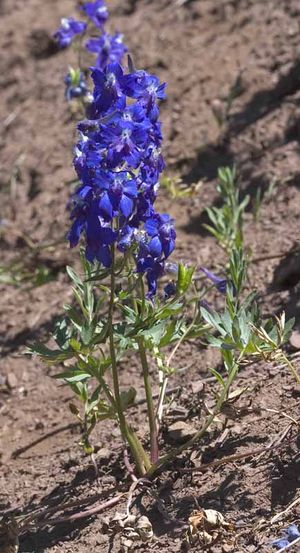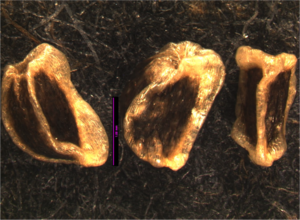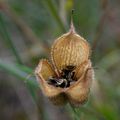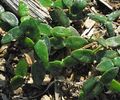Delphinium menziesii
- Latin Name: Delphinium menziesii
- Family: Ranunculaceae
- Common Names: Menzie's larkspur
- Codon: DELMEN
Contents
Taxonomy
| Scientific classification | |
|---|---|
| Kingdom: | Plantae |
| Subkingdom: | Viridiplantae |
| Phylum: | Tracheophyta |
| Subphylum: | Spermatophytina |
| Class: | Magnoliopsida |
| Subclass: | Magnoliidae |
| Order: | Ranunculales |
| Family: | Ranunculaceae |
| Genus: | Delphinium L. |
| Species: | Delphinium menziesii DC. |
| Synonyms | |
| |
Description
Plant:Perennial from tuberous, clustered roots and usually less than 50 cm high. The stem is single and very slender usually with very fine hairs.
leaves: are stalked and are mostly on the stems with the longest stalks on the few basal leaves and becoming shorter as they grow farther up the stem. The main leaf blades are two or three times palmately divided into narrowly oblong to wedge-shaped segments.
Flowers: are violet with the uppermost of the five petals being modified into a pronounced hollow spur. The petals are shallowly notched, ruffled, veined and wavy-edged. The upper two petals are often white. The lower flower-pedicals are usually much longer than the flowers. The flowers occur in 3-20 open, loose simple to branched terminal clusters.
Blooms: from May on the coast to June and July in the higher meadows
Bloom Period
April to July
Distribution
Chiefly west of the Cascades, British Columbia to California; occasional east of the Cascades in Washington.
Habitat
Coastal bluffs and prairies to moist meadows and forest openings at moderate elevations in the mountains. Delphinium menziesii occurs in rich well drained soils and full sun.
Uses
POISONOUS PARTS: All parts. Highly Toxic; May be Fatal if eaten. Symptoms include burning of lips and mouth, numbness of throat; intense vomiting and diarrhea, muscular weakness and spasms, weak pulse, paralysis of the respiratory system, convulsions. Toxic Principle: Alkaloids delphinine, ajacine, and others. (Poisonous Plants of N.C.). Inhibits the growth of nearby plants, especially legumes.
The First Nations have recorded uses of Dephinium menziesii as a poultice of the stalks and roots that has been applied to sores. A parasiticide is obtained from the leaves. It is quite toxic and so is for external use only. A blue dye can be obtained from the flowers.
Gardeners purport that this plant is an attractant and pollinated by hummingbirds, butterflies and bumblebees.
Propagation
Sow seeds in March/April in a cold frame or May outdoors. Keep moist and in a shady position until germination takes place. The seed has a limited viability so it should be stored in a sealed container at about 3°c. Temperatures above 15°c inhibit germination. The seed usually germinates in 2 - 9 weeks at 15°c. When they are large enough to handle, prick the seedlings out into individual pots and plant them out into their permanent positions in the summer. Cuttings of basal shoots in April/May, taken before they become hollow at the base, and planted in a cold frame. Division in spring or early autumn.
Seed
Seed sample from 2009
Features
Average measurement: 1.9 x 1.2 x 1
Measurement range: L: 1.5 – 2.3, W: 1.1 – 1.3, D: 0.9 x 1.2
Latitudinal cross section: obovate ![]()
Longitudinal cross section: elliptical ![]()
Seeds dark brown in a roomy, clear/white seed coat that bunches around hilum and seed edges. Bagginess of seed coat sometimes gives the seed a winged appearance.
Seed coat very finely longitudinal striate and glossy.
Basic Explanations and Assumptions:
The dimensions for the seeds are length x width x depth. The location of the hilum is used as the base of the seed, and the length is measured from hilum to the opposite apex. Where a style is present, the length is measured from the hilum to the bottom of the style. Width is measured at a right angle to the length at the widest part. Depth is measured at a right angle to the intersection of height and width lines.
Measurements included are the mean average for each measurement of ten separate seeds.
All measurements in millimeters unless otherwise noted.





